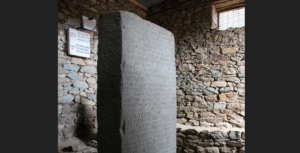The Ezana Stone is an ancient stele still standing in modern day Axum, the centre of the ancient Kingdom of Aksum. This stone monument, that probably dates from the 4th century of the Christian era, documents the conversion of King Ezana to Christianity and his conquest of various neighbouring areas, including Meroë. The name Ezana is possibly of Amharic origin and means “King of king elected by God king of axume”. An other opinion suggests that Ezra is a biblical name meaning “help” or “helper” in Hebrew. The Ezra of the Bible was a Jewish priest who helped reintroduce the Torah to the Jewish people who escaped captivity in Babylon.
From AD 330 to 356, King Ezana ruled the ancient Kingdom of Aksum centred in the Horn of Africa. He fought against the Nubians, and commemorated his victories on stone tablets in praise of God. These liturgical epigraphs were written in various ancient languages, including the Ethiopian Semitic Ge’ez, the South Arabian Sabaean, and Greek. The king’s engravings in stone provided a trilingual monument in different languages, similar to the Rosetta stone.
The Philistines were likely of Greek origin, according to new DNA evidence
The earliest known inscriptions in the Ge’ez script date to the 5th century BC. At first the script represented only consonants. Vowel indication started to appear in 4th century AD during the reign of king Ezana, though might have developed at a earlier date.
Read more: The archaeologist
Ask me anything
Explore related questions





